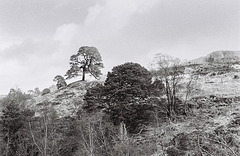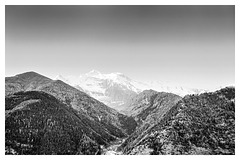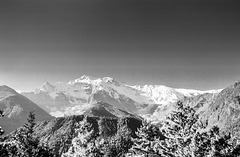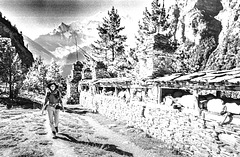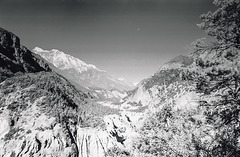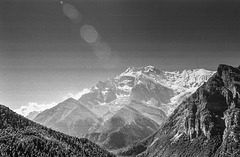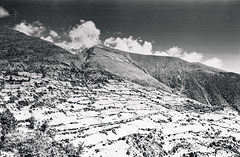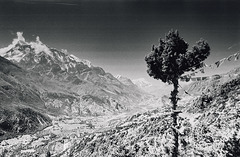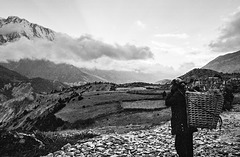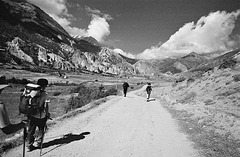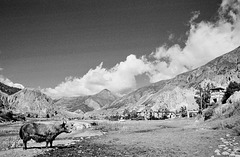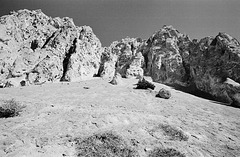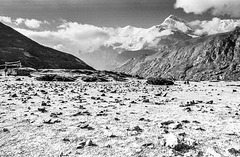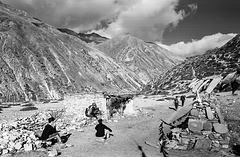
Nepal नेपाल
Velvet the Himalayan poinsettia in bloom,
silver the scabbard of thrusting power,
the mind is a clear scent,
the pen is a new ridge of hills.
I am a tree with countless boughs,
a flower which hides a thousand petals,
a juniper, a pointed branch of the scented fig,
its rough, misshapen fruit.
In my belief I am Nepali,
my faith the highest Himalaya,
my favourite season is the one
when leather jack…
(read more)
000042
| |
|
03910002
| |
|
Everyday scene (for some)
| |
|
|
m a n i s t o n e s
| |
|
|
Mani stones (མ་ཎི་རྡོ་འབུམ།) are stone plates or rocks that are carved with the Tibetan Buddhism six-word mantra Om Mani Padme Hum.
The first word, Om , symbolizes the practitioner’s impure body, speech, and mind; it also symbolizes the pure exalted body, speech, and mind of a Buddha. Mani meaning jewel, symbolizes the factors of method: altruistic intention to practice compassion and love. Padme , meaning lotus, symbolizes wisdom. Purity must be achieved by an indivisible unity of method and wisdom, symbolized by the final syllable Hum , which indicates indivisibility.
Thus the six syllables, om mani padme hum, mean that in dependence on the practice of a path which is an indivisible union of method and wisdom, you can transform your impure body, speech, and mind into the pure exalted body, speech, and mind of a Buddha. But nowadays people also carve other texts from Buddhism.
The Mani stone is the one of the most popular forms of prayer and ritual in Tibetan culture. It’s originally from Bon’s stone worship. When you are traveling to Tibet, you will find a lot of Mani stones. They are intentionally placed along the roadsides and rivers or placed together to form a big stupa, temple and mountain shapes. People also place the Mani stones along walls, as an offering to spirits of a place.
Around mani wall
| |
|
|
|
03920001
| |
|
See a skull?
| |
|
|
|
Annapurna II sits apart from the main ridge of the Annapurna Massif, along with the shorter Annapurna IV. Its summit proper lies along a steep rock ridge, relatively free of snow towards its highest point, which drops in altitude to run west to the summit of the smaller peak. The South Face is a large pyramidal wall only interrupted by the central spur, while the North Face is more complex, with steep walls cascading between ice fields near the summit and base of the mountain. To the northwest, a large hanging glacier occupies the flank between it and Annapurna IV, while the Northeastern wall has a distinctive, recurrent series of cornices and rock bands resembling a human face or skull, visible in the above photograph.
Burned by the Sun
| |
|
|
Humde airport from the way to Upper Pisang, trekki…
| |
|
|
|
Manang (Humde) Airport is situated at Manang District, Province No.4. The District is still not connected with the road network and hence the airport serves as a major means of transportation. The airport is situated in the world famous Annapurna round trek route and is located at highest elevation of 11092 ft among the operational airports of the country. This airport also serves as the gateway to Tilicho Lake. caanepal.gov.np/storage/app/media/uploaded-files/Manang%20Airport.pdf
Flights to and from Humde started in July 1982. Back then, two regular flights used to be operated every week from Humde. Locals say that flights stopped when a road track to Manang opened. A flight from Pokhara to Manang takes around 25 minutes, however planes cannot fly to Manang in snowy or rainy weather.
Back home with a basket full of yield
| |
|
|
|
Back home
| |
|
|
|
Evening in the mountains
| |
|
|
|
03920010
| |
|
|
Domestic yak
| |
|
|
03920012
| |
|
|
03970001
| |
|
Closer to the top
| |
|
|
|
Those who never take trekking journey might not know these moments. This is the best part of the journey, you already do not feel any pain, you just walk and walk, enjoy the wide plains. In these moments you just found your inner peace. In these moments you might not take the pictures because it does not matter - to show friends your best moments? you've already clicked the peaks, and then you'll do a final on top. Heh. These parts are for your selves. These parts of journeys are sacred, dreamt, relaxed, filled with inner peace.
Passing a stone cairn, enjoying a small refreshmen…
| |
|
|
In Himalays, the stacks of carefully placed stones translated in english as "cairns" are often aligned beside rivers and at mountain alters, making the path-markers on a trail. While this is true for Nepal as well, cairns hold a much more cultural meaning than just direction-pointers. Both Hinduism and Tibetan Buddhism, two major local religions, have philosophies that indicate every sentient being is connected to the universe. Many cultural symbolisms occur in the form of stones in old legends,including the local shamanistic traditions.Cairns in the Himalayas are also often ornamented with prayer flags, and the stones are often arranged in a certain way, with some even worshipped as altars to the gods.
Jump to top
RSS feed- Latest items - Subscribe to the latest items added to this album
- ipernity © 2007-2024
- Help & Contact
|
Club news
|
About ipernity
|
History |
ipernity Club & Prices |
Guide of good conduct
Donate | Group guidelines | Privacy policy | Terms of use | Statutes | In memoria -
Facebook
Twitter

